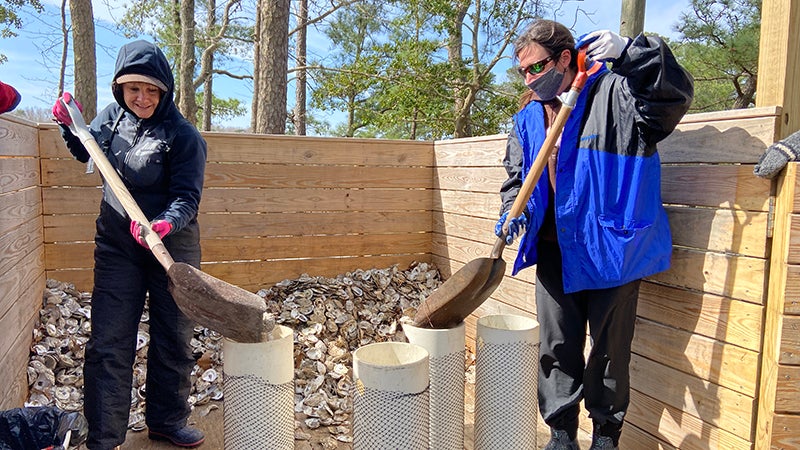Bagging oysters for tomorrow’s waterways
Published 8:27 pm Monday, March 22, 2021

- Sherri Matthews, volunteer, and Jackie Shannon from the Chesapeake Bay Foundation take their turn shoveling oyster shells collected by Decoys restaurant into netted bags.
|
Getting your Trinity Audio player ready...
|
As Suffolk keeps developing, the Nansemond River Preservation Alliance is helping make sure the many surrounding waterways are healthy for generations to come.
The Nansemond River Preservation Alliance, along with volunteers, spent its Saturday morning of March 20 bagging oysters for a local research project.
This research project is part of the NRPA’s partnership with the Chesapeake Bay Foundation for Virginia oyster restoration. The shells will be used as one of the five different oyster substrates. Substrates are what oysters in their larval state latch onto to grow.
“What you’re doing today is helping not only today but for future waterways,” said Elizabeth Taraski, president and chief executive officer of the preservation alliance, told the group of about a dozen volunteers.
Volunteers from NRPA and the GFWC Junto Woman’s Club took turns stretching netted bags, shoveling oysters into the bags, and closing and loading the bags onto a trailer for the Chesapeake Bay Foundation. These bags of shells will be one of the substrates tested along with the concrete reef balls volunteers made in October 2020.
Also helping was Teresa Mullins, owner of Decoys Seafood. Since August, Decoys has collected and donated oyster shells from the restaurant for the NRPA to use for this project. The large wooden stall at the NRPA used to store the oyster shells will be donated to the Nansemond Indian Nation to continue collecting shells to make more substrates.
“I am happy to be a part of this great cause,” said Mullins. “Everyone loves oysters, but we have to make sure to have some for years to come. I’m glad we could bring this to folks’ attention and give back to the community.”
The netted bags of oyster shells and other substrates will be placed in the shallow waters along the Nansemond River by the Chesapeake Bay Foundation and Nansemond Indian Nation on March 24. In April, the foundation will look and collect data from the different substrates and how many oysters are attached.
“We are happy to be able to partner with the NRPA for our living oyster projects and experimental designs,” said Jackie Shannon, Virginia oyster restoration manager for the Chesapeake Bay Foundation. “This is easy to do with volunteers, and I’m excited to work together on this.”
According to the NRPA, one adult oyster can filter up to 50 gallons of water per day, removing bacteria, nutrients and suspended solids from the water. With a lack of oysters, waters can get dangerously unbalanced levels.
The NRPA started 10 years ago to help restore the waterways around Suffolk. The alliance has engaged and educated the community to do what they can to help the waterways through different projects and partnerships.
“Its success is through its collaboration,” said Lorraine McGovern with the GFWC Junto Woman’s Club. “Everyone is excited and feels good about helping. It’s only two or three hours periodically, and they know they are making a difference.”
The NRPA is continuing to look for more ways to communicate its goal of educating the community to keep the waters clean. The alliance is currently putting together learning kits for students since they can’t personally go into the schools this year. This kit will teach about water ecosystems in creative ways to learn in the classroom or at home.
“We have many active volunteers,” said Taraski. “Suffolk is a wonderful area with talented people, and many are retired and have skills they want to use to help the next generation.”






